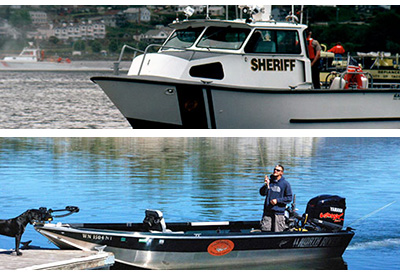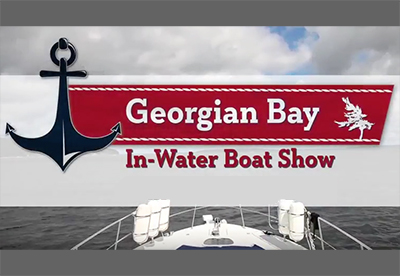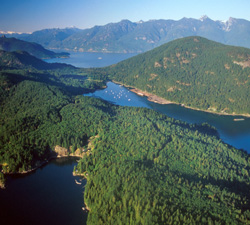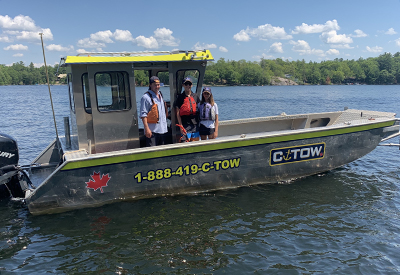Boating in the Biosphere
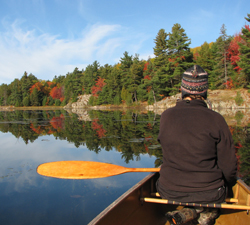
By: Jennifer Harker
The 30,000 Islands of Georgian Bay is a boater’s dream destination with crystal clear waters, endless anchorages, amazing angling opportunities, outstanding scenery and diverse wildlife and vegetation. It is also a United Nations Educational Scientific and Cultural Organization (UNESCO) world biosphere reserve, a designation awarded in 2004 after seven years of intensive work by a collective of cottagers, boaters, residents, First Nations representatives and organizations with support from government agencies.
Established in 1998, the Parry Sound based non-profit organization Georgian Bay Biosphere Reserve Inc. includes geographically diverse volunteers from all walks of life who share a common ‘Georgian Bay feeling’. It continues to facilitate vital community partnerships and fulfill the biosphere mandate.
Communications manager Dr. Becky Pollock said, “When people ask why we were designated, we like to tell them that we had to meet strict international criteria relating to the quality of the ecosystems here and the potential for conservation and sustainable development.”
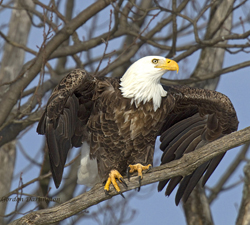 Around the globe there are over 600 biosphere reserves in 117 countries with 16 of these living laboratories and platforms for sustainable development in Canada, including the Georgian Bay Biosphere. Considered the world’s largest freshwater archipelago, this biosphere encompasses 347,269 hectares of shoreline ecosystem stretching over 200 km from the Severn River at its southern edge to the French River in the north. Bordered by the Highway 69/400 corridor in the east, its western edge extends out into Georgian Bay to the Limestone Islands Nature Reserve although the boundaries are considered flexible and can change over time.
Around the globe there are over 600 biosphere reserves in 117 countries with 16 of these living laboratories and platforms for sustainable development in Canada, including the Georgian Bay Biosphere. Considered the world’s largest freshwater archipelago, this biosphere encompasses 347,269 hectares of shoreline ecosystem stretching over 200 km from the Severn River at its southern edge to the French River in the north. Bordered by the Highway 69/400 corridor in the east, its western edge extends out into Georgian Bay to the Limestone Islands Nature Reserve although the boundaries are considered flexible and can change over time.
In all over 100 different types of habitat have been identified that support staggering diversity including 170 breeding bird species, 44 different types of mammals and 34 species of reptiles and amphibians earning it a reputation as a herpetological hotspot. Pollock said, “When we speak with student groups, we compare the Georgian Bay in their backyard as the ‘Galapagos of the North’ – which is to say that we are unique on the planet and we host one of the highest populations of reptiles and amphibians in Canada.”
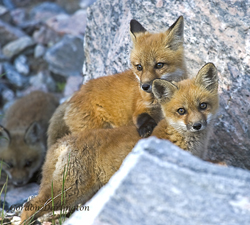 Conservation of ecosystems, biodiversity, genetic variation, species and landscapes is key to a successful nomination under UNESCO’s Man and Biosphere program, established in 1970. Along with conservation, sustainable development – both economic and human – and support for education, research, training and monitoring form the group’s mandate. Pollock explained, “Biosphere reserves require core areas that have legal protection, in our case: one national and several provincial parks, and biodiversity should be protected across the entire landscape i.e., not just in parks. We are blessed to have a large percentage of Crown Lands and islands that greatly increase the protection values of our area. There are much lower rates of habitat fragmentation by roads here so far, for example, which greatly enhances the biodiversity – certainly for species at risk, like our turtles and snakes.”
Conservation of ecosystems, biodiversity, genetic variation, species and landscapes is key to a successful nomination under UNESCO’s Man and Biosphere program, established in 1970. Along with conservation, sustainable development – both economic and human – and support for education, research, training and monitoring form the group’s mandate. Pollock explained, “Biosphere reserves require core areas that have legal protection, in our case: one national and several provincial parks, and biodiversity should be protected across the entire landscape i.e., not just in parks. We are blessed to have a large percentage of Crown Lands and islands that greatly increase the protection values of our area. There are much lower rates of habitat fragmentation by roads here so far, for example, which greatly enhances the biodiversity – certainly for species at risk, like our turtles and snakes.”
Although the designation has no legal power to prevent development or stop malpractice, Pollock maintains it is still vital to create what she terms good moral suasion. “It is the environmental consciousness for the community. A Biosphere Reserve designation creates a sense of pride, and pride of place. It is an international recognition of special places. It provides a framework for thinking about environment and development in a particular place, for the present, and for future generations.”
 She said although Georgian Bay is considered to be in good condition compared to other Great Lakes, “There are still a number of threats and pressures to ecosystem health, including: invasive species, climate change, water levels, and development including roads and shoreline alteration.”
She said although Georgian Bay is considered to be in good condition compared to other Great Lakes, “There are still a number of threats and pressures to ecosystem health, including: invasive species, climate change, water levels, and development including roads and shoreline alteration.”
The UNESCO designation has positively altered habits and perceptions. “Some property owners are more informed about why their land has ecological value,” Pollock said. “Some residents and cottagers are more engaged in best practices, after we have provided them with information and training. Some have said, ‘I want my grandchildren to learn this, so they can take good care of this place.’ Boaters are often as passionate about the bay as any other group; and some marinas are in a position to point out the significance of the designation.”
Biosphere board member Michael Vollmer has been cruising the bay for half a century, most recently aboard Chippewa, a custom wooden launch built in 1936 and restructured in 1986. He was honoured to be asked to help create the biosphere and said it brought together many groups previously at odds, focusing efforts on something they all love – Georgian Bay. “The bay has something for every boater, broad stretches, a myriad of comfy little anchorages so private they’re often not on the chart and larger spots where a group of friends can find a common anchorage. The bay has a fascinating collection of rocks which allow, indeed force you, to work on your navigation skills. Every day you will be rewarded with stunning sunrises and sunsets … more than just memories.”
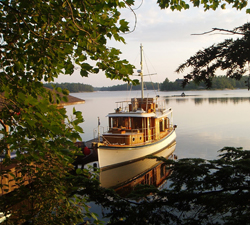 To preserve this irreplaceable treasure Vollmer said boaters must minimize their environmental impact. “Every dock has ample garbage and re-cycling bins, use them! Ensure you boat is well maintained so that oils and other boat stuff does not get pumped overboard. This entails good maintenance of your mechanical systems and the use of hydrocarbon absorbents in the bilge. Not rocket science at all.” He recommends looking for the Environment Canada Enviro Logo on cleaning products and encouraging marinas to be part of the Ontario Marine Operators Association Clean Marine Program. “We all rely on the environment for our enjoyment so let’s protect it!”
To preserve this irreplaceable treasure Vollmer said boaters must minimize their environmental impact. “Every dock has ample garbage and re-cycling bins, use them! Ensure you boat is well maintained so that oils and other boat stuff does not get pumped overboard. This entails good maintenance of your mechanical systems and the use of hydrocarbon absorbents in the bilge. Not rocket science at all.” He recommends looking for the Environment Canada Enviro Logo on cleaning products and encouraging marinas to be part of the Ontario Marine Operators Association Clean Marine Program. “We all rely on the environment for our enjoyment so let’s protect it!”
Past executive director of Ontario Sailing and one of the biosphere’s founding board members, Al Will has been connected to the bay since he first went to Camp Hurontario in Twelve Mile Bay, back in 1956. A passionate sailor, Will said the annual Georgian Bay Regatta is a great way to explore and discover the bay and the biosphere. One of his most memorable moments came on a windless day when the race committee gave the fleet a choice to follow an experienced skipper out to the Western Islands. “The Westerns are a perfect example of preservation of what the Georgian Bay Biosphere Reserves stands for. Because of being the furthest ‘out-islands’ only large or fast boats with experienced skippers should attempt the crossing. The islands are high and the view is awesome. Here you really can see 30 feet to the bottom.”
Will said individual boaters can make a difference with their daily habits like reducing grey water from the galley sink. “We use paper towels to attack any greasy pans or dishes before washing them. If you swim every day, or two or three times a day that we do, you really don’t need any body soap or shampoo.” To help preserve the biosphere he adheres to the popular expression, take nothing but pictures and leave nothing but footprints.
For the biosphere’s continued preservation and sustainability, Pollock said financial support including donations, memberships and corporate sponsors as well as volunteer support is essential. “We always welcome volunteers and consider them champions and spokespeople for the organization,” Pollock said. “We encourage subscribers on our website to keep informed and stay involved. Ideally we would create an endowment fund to support environmental education.”
Individuals can actively help with programs such as Lessons-in-a-Backpack for teachers with on-line lesson plans; encouraging ‘stewardship parties’ with the on-line guide Life on the Bay; monitoring programs for lakes and wetlands; reporting species at risk sightings; taking a plot and growing food (20% of which is donated to local food banks) in the Parry Sound community gardens; and sharing and acting upon the soon-to-be released ecosystem health report card called State of the Bay.
Membership is open to anyone, whether they live within the biosphere reserve or not and GBBR has 85 business or organization corporate members and 200 individuals and families. With hundreds of Facebook fans and over 1,000 contacts receiving the online newsletter membership continues to grow. To learn more join the Facebook page www.fb.com/GBayBiosphere visit the website www.gbbr.ca or call 705-774-0978.
Photo Captions:
Photo 1 – Financial Support of the Georgian Bay Biosphere Reserve helps ensure future generations will enjoy it. Credit: Kenton Otterbein
Photo 2 – With over 100 different types of habitat, the biosphere is sometimes called the Galapagos of the North. Credit: Gord Darlington
Photo 3 – the ecologically diverse Georgian Bay Biosphere is home to an astounding variety of birds, mammals, reptiles and amphibians. Credit: Gord Darlington
Photo 4 – Conservation of that biodiversity was one of the key components to the region earning UNESCO world biosphere designation in 2004. Credit: Scott Gillingwater
Photo 5 – By altering their habits in small but significant ways boaters can reduce their impact and continue to enjoy the unique beauty that is the Georgian Bay Biosphere. Credit: Thom Morrissey

